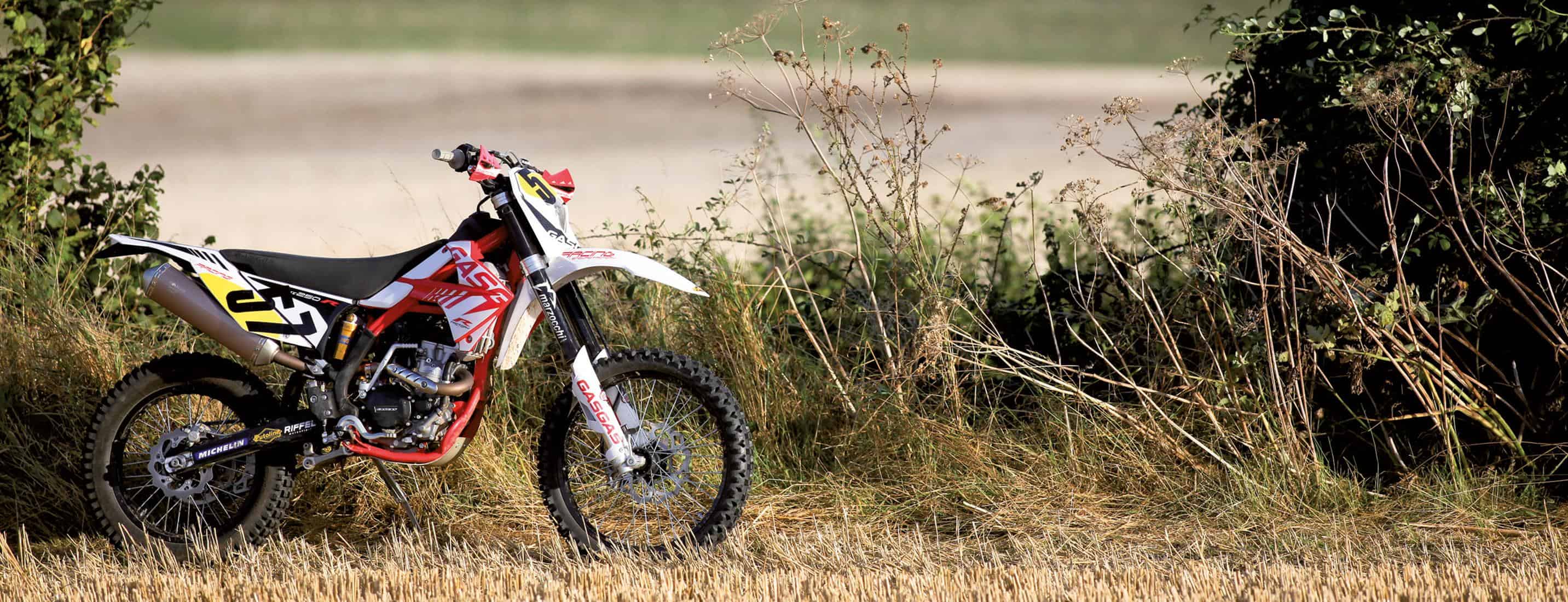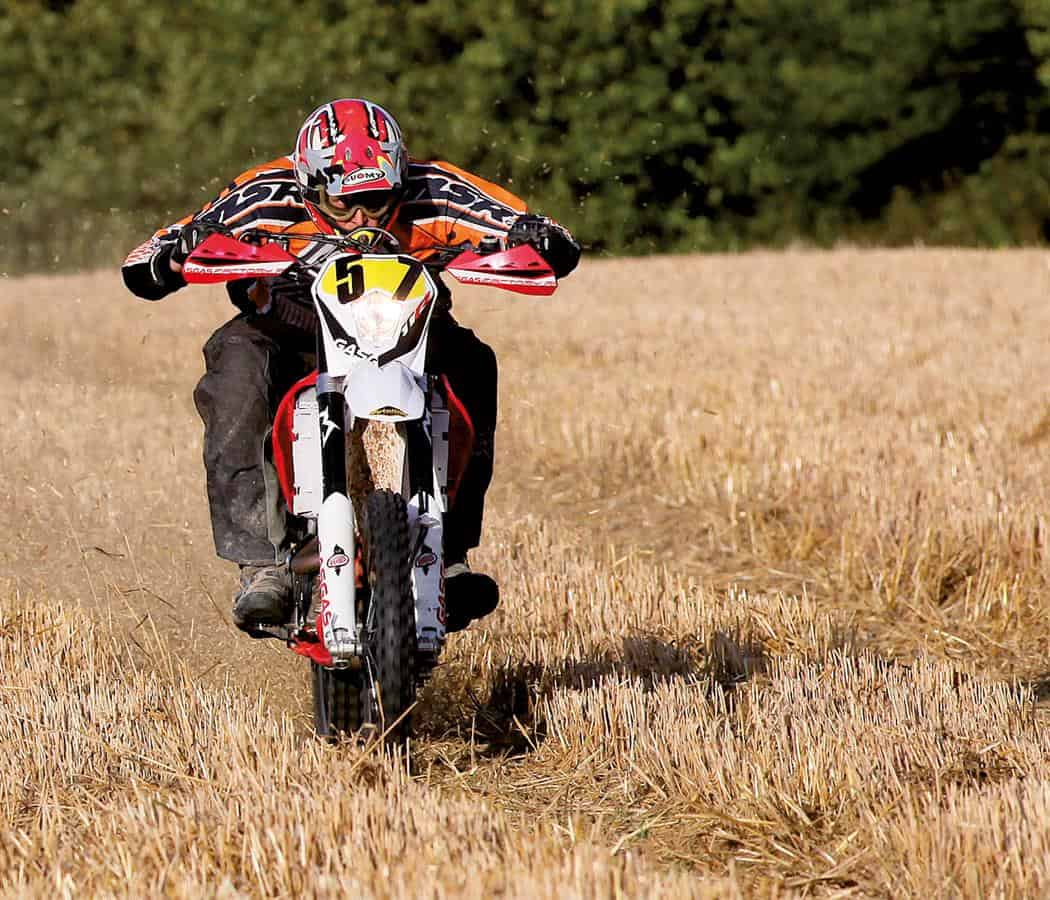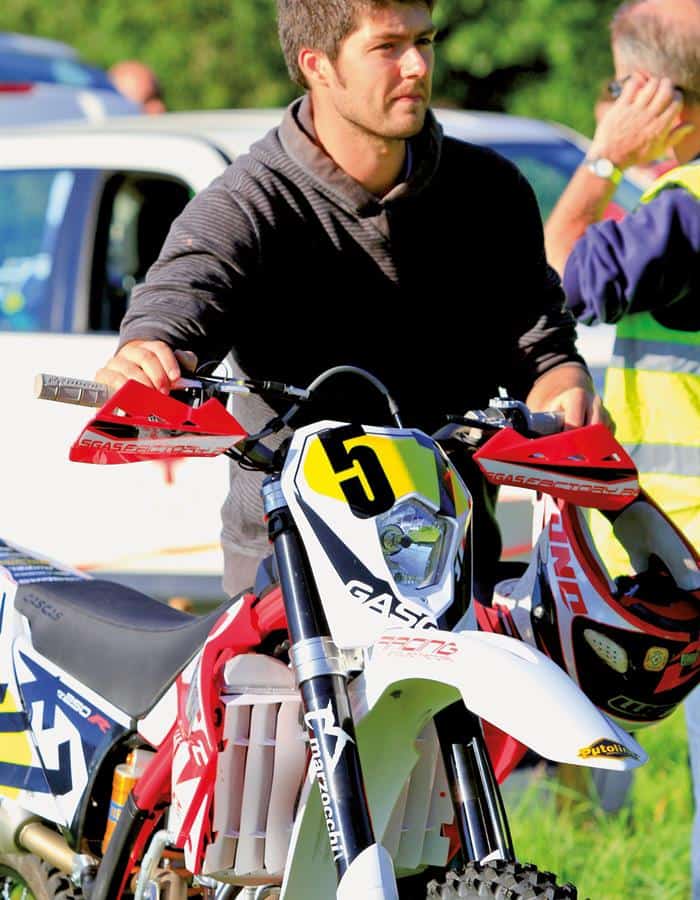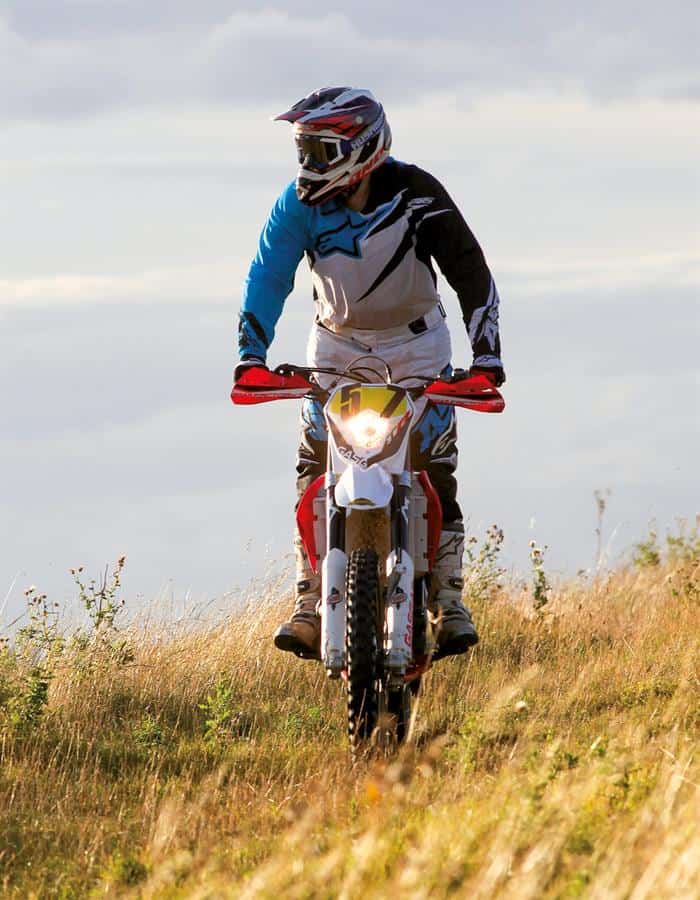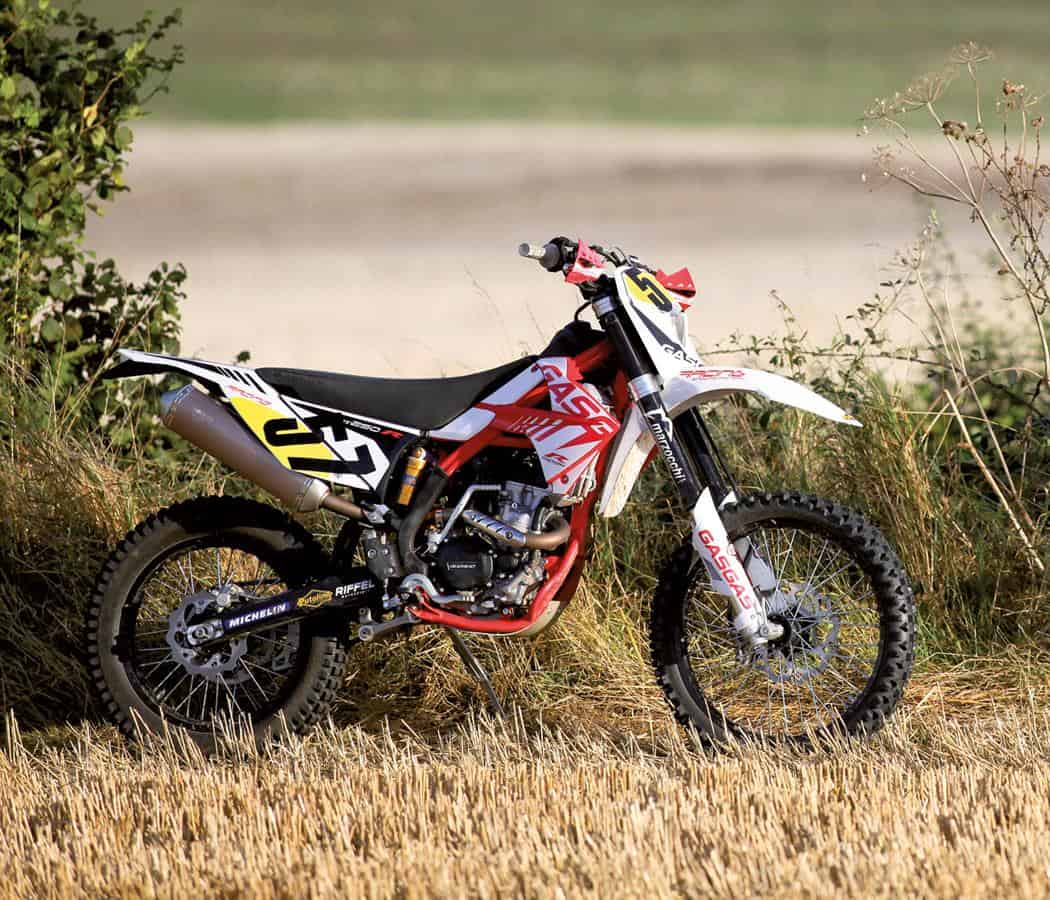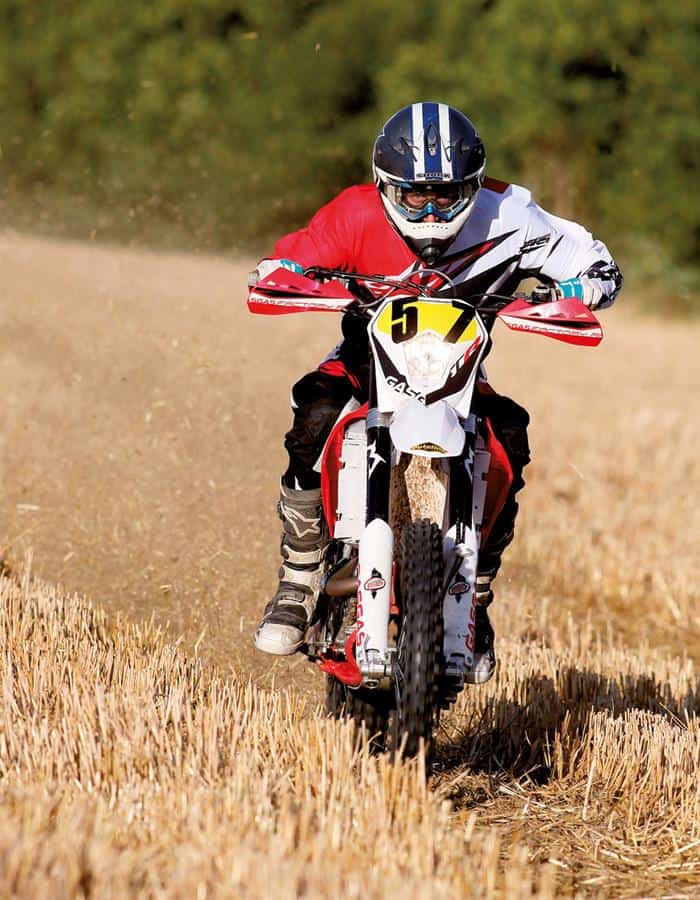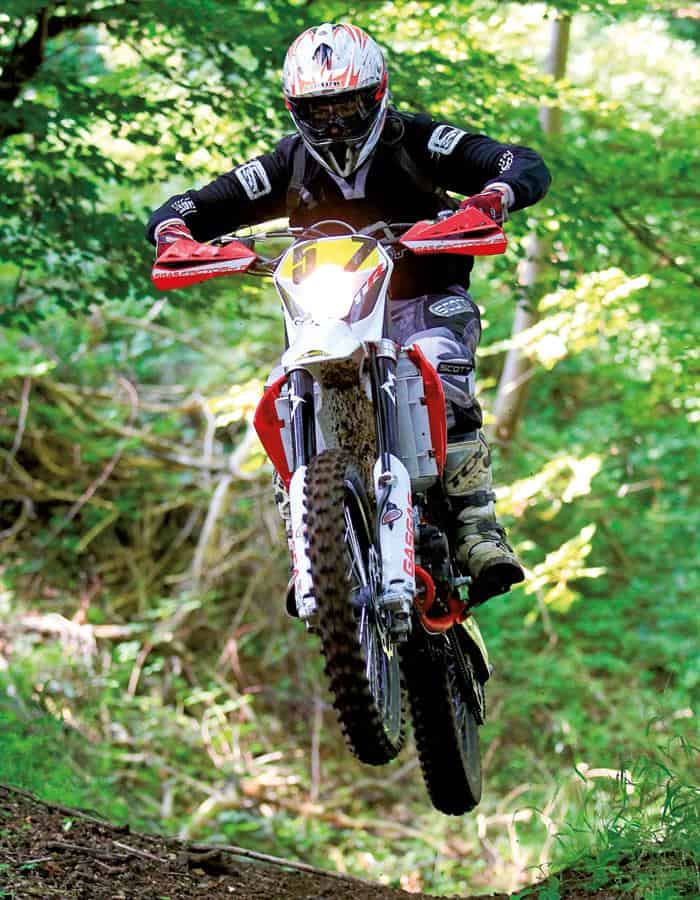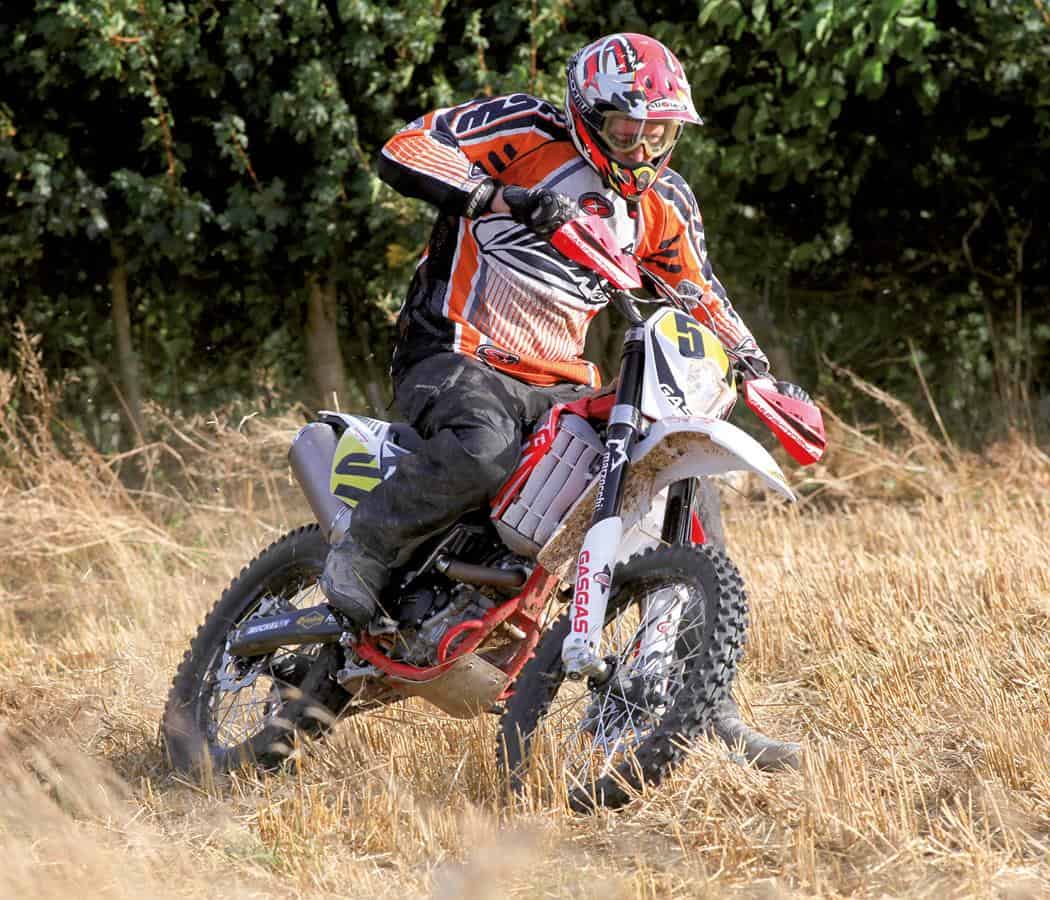If bikes were judged on sound alone then the 2013 Gas Gas EC250F Racing would win every single shootout…
Right, I’m going to be totally honest about this from the outset, I wasn’t really looking forward to riding the 2013 Gas Gas EC250F Racing. In fact I considered that I might enjoy it even less than having to listen to my fellow competitors blather on about ‘the good old days’ in the pub the night before the test. And this was before I’d even set eyes on the thing.
Call me a big girl’s blouse if you must, but being close to death with a nasty dose of man-flu (snivel) the thought of an early start and a five hour race really wasn’t all that appealing. It wasn’t just what felt like the final stages of the ebola virus (minus the intestinal leakage) that was quashing my usually unbreakable enthusiasm either. You may recall this particular bike attracting some less than enthusiastic reviews back when it was first launched. The final upshot being that the 2010 model Gas Gas EC250F was felt to be ever so slightly lacking in the design, detail AND performance departments.
I will freely admit at this point that I never even set eyes on that particular bike, let alone rode it, so I won’t be comparing old with new here. But if anything, I think that should help in providing what can only be a completely unbiased opinion. As my mother once said to me ‘If I don’t expect much from you then I will be all the more surprised and impressed when you do manage to get something right’. Bless her. She’s still waiting…
So what we have here is essentially Gas Gas’s attempt to get a slice of the ever-popular 250 4T market by taking someone else’s engine and sticking it into their chassis. Fair enough I reckon; it’s not like we’ve never seen this before from other European manufacturers.
From an engineering point of view it’s pretty time-consuming and expensive to develop your own single cylinder four-stroke engine, especially so if you haven’t got any multi-cylinder R&D to borrow from. So why not play to your strengths, buy someone else’s bombproof, well-proven engine and simply plonk it into what is arguably one of the greatest clubman dirtbike platforms ever created? Sadly, at their first attempt Gas Gas managed to mess up the concept and produced what is best described as a Smartprice Tiramisu on an already well stocked shelf of fresh cream cakes.
The thing looked reasonably good and promised much but in reality, well, yeah, no-one appeared to be hurrying back for seconds. But hey, that was 2009 and a lot has changed at the Spanish concern since then. Effectively what we are now looking at is the refined version; and perhaps most importantly one that has been built under the new regime which promises a determined focus and motivated drive towards quality.
So, has evolution been kind to the featherweight four-stroke?
The first thing to notice about the 2013 EC250F is that it is not black. The bike’s plastics have been restyled, with sharper creases and a refreshingly simple set of graphics. I have to say that I’m also quite sold on the whole black, red and white thing that makes the bike look a bit like an Arsenal scarf. In fact I reckon that the sharp styling of the whole EC range is pretty spot on. It’s current, stand-out and cool.
Running a critical eye over the 250F reveals that the resurgent drive for quality appears to be more than a hollow marketing promise. The plastics have a robust, quality feel to them and the general fit and finish of the fittings is a match for any of the big enduro players. That said, one or two details are still a way off the Teutonic perfection we’ve come to expect and there is still a familiar hint of Gas Gas with a few aspects still not quite achieving the new standard.
The top of the plastic fuel tank for example has a sort of rough cast texture to its surface which looks a little bit cheap (might just have been this bike?) and the frame finish could definitely be better in places (although the large frame guards are a nice touch to keep it from getting tatty too quickly). But as I’ve already said it’s a giant leap in the right direction in terms of quality and detail, especially for a company that has traditionally only invested in how its bikes rode rather than how they would on keep riding. By and large it actually feels like a genuine quality product that is built to a proper standard.
The backdrop for our test was to be the Foxwell timecard enduro, an event aimed squarely at the clubman rider looking to get a first taste of timecard experience. The going promised a thirteen mile loop hewn from a heady mix of tight woodland singletrack and fast, open vistas all set within the bounds of the glorious Bathurst estate near Cirencester in Wiltshire. Apparently there were six laps to complete, including two timed special tests and an ever decreasing amount of time to stay your minute. Did I mention that I was ill?
Preparation-wise the bike was more-or-less ready to rock. Thankfully the bike had been supplied with the requisite trials hoop fitted to the rear (Black Excel rims and quick release axles fitted front and rear as standard by the way) and so some inappropriately sized race numbers and a quick adjustment of the (braceless) bars and lever positions was all that was needed. I’m pleased to say that this task now requires only two tools on this machine; one for the bars and one for both lever perches – wahey!!
Pushing the bike through scrutineering I hear a marshal remark ‘I’d take a moment to enjoy the bike looking like that mate, it’s the last time it will look that clean!’ He’s got a point too; the bike is box fresh and squeaky clean. A quick prod at the buttons on the (frankly completely unfathomable) Gas Gas branded digital display reveals there to be a whole 6km logged. I make a mental note to apply some gentle mechanical sympathy until things have had time to bed in a bit.
Zero hour is to come at 10:14am precisely with a dead engine start (no engine warming up allowed) and with three other riders on my minute. Fuelled up on Lemsip and handfuls of Ibruprofen at 10:13 and 45 seconds it suddenly dawns on me that I’ve never even started this bike before. I attempt to turn the fuel on (no markings on tap, presume down), put choke on, starter ready. 10:14 clicks over and the bike fires up cleanly and positively on the first half a turn of the eager starter. Were on!
With my timecard filled out and safely stashed, it’s out onto the course and the first thing to attack the senses with the EC250F is the noise. For a little 250 this thing howls! That said it’s kinda weird actually because while I would say it’s definitely on the loud side it’s never annoyingly so. For the trail however some would undoubtedly find it a bit much (myself probably included) but in a race setting it seemed an acceptable level of dBs.
The first few miles are spent following the rider in front whilst trying to warm-up both myself and the bike. Initially my reluctant, disease-ridden body feels awkward and stiff and I’m just not feeling all that comfortable on the bike. The bars feel a little low, the gear-change is a bit clunky and the eagerness of the motor, coupled with the growl of the pipe is not doing much to help my banging head and slow reactions. Inevitably these factors coupled with a lack of any bike time for the previous 10 weeks finally claims its toll and I bite the dirt relatively hard under some trees at about 20mph following a disagreement with a slick tree root.
From my newly adopted supine position on the ground I watch the bike slide painfully along on its side before thunking head-on into a nearby tree. I curse myself for the stupid error and walk over to fetch the bike which is still merrily ticking over on the ground. A quick inspection reveals no broken plastics, scratches or twisted forks. In fact there is no discernible damage whatsoever. Integrity of the newly claimed ‘unbreakable’ plastics? Tested!
With a crash out of the way early I got some focus back and started to relax into things a little better. With my confidence building, the peppy eagerness of the motor morphed from being mildly annoying to utterly awesome. The same goes for the exhaust note that switched from making my head hurt to motivating my riding massively. No, seriously. The crisp braaaahppp, burrrrrrb (pop) noises this thing makes just adds to the fun; fun which is then amplified many times by the instantaneous throttle response.
I’m not sure what Gas Gas have done to the fuelling; but its nigh-on perfect. There is literally no throttle bog and no lag, just instant, useable, controllable, power that builds easily up to a strong mid-range and a half-decent top end. Sure its no KTM 250EXC-F at the very limit, but keep it on song with the pipe singing and progress at the top is rapid. Perhaps a little less-so than my re-jetted 2004 Yamaha WR250F which shares the same engine and essentially the same carburettor, but it’s pleasantly thrashable along the straights.
To be honest the straights are not where it’s at with this bike though. The real fun is to be had threading through the trees in the loamy leaf mulch, pushing down hard through the pegs into the berms before shifting your body up and standing the bike upright. Powering from second to third; just touching fourth for a split second before skipping back down to second (blipping the razor-sharp throttle on the downshifts – just for the sake of it) is laugh-out loud fun. But even when the chips are down and the conditions are slick you can easily trickle this thing through the trees in first gear on the throttle – trials-style – and that’s something I definitely won’t be doing on my Yam.
The first lap is what’s known in the trade as a ‘slack check’ with a generous 55 minutes available to complete the miles. The object of this extra time is to allow the rider to maintain a reasonable pace and make mental notes of where one might go faster and where caution might be exercised. Or at least that is what I imagined a reasonably adept racer might be doing with their time.
Me? I was just settling into the Gasser more and more and generally having a ball jumping it off things, riding over stuff, missing turnings and hanging the tail out wide through the longer fast corners whilst remarking out loud (to myself of course) that this bike was brilliant! At a reasonable pace the first lap took around 40 minutes to complete for most riders leaving time enough at the end of the lap for a drink, fuel check and a banana. The discretely tucked away tank on the 250F looks deceptively small but holds a fairly reasonable 6.3L when brimmed and I reckoned on using around two litres per lap under race conditions. In reality my complete lack of any strategy meant that I tended to panic and top up every lap if I had any spare time before my minute.
I figured at this point that given my present medical condition (have I hammed this up enough?) the second and third laps were gonna’ be the most important as the time allowed was tighter at 45 minutes per lap and the special test sections were going to be timed. Clocking in on my minute I headed back out and started the risky task of trying to up my overall pace by stringing together the bits of the course that I could remember from the first lap. Instead of simply cruising in fifth gear on the fast early sections of the lap I wound the little Yam engine wide open for as long as I dared.
With the increased speeds came some hard hitting yumps and bumps along the straights and to be fair the Marzocchi/Ohlins setup mostly lapped it up. I say mostly because on some of the faster hits the forks did feel as though they might be nearing the end of their useable travel. I would hesitate to point out here that I weigh 14 stone on a light day (92kg) and that as a stock bike it did feel as though the factory settings were slightly on the soft side – even on this ‘Racing’ model.
It would be unfair to expect any miracles straight out of the box. Remember no adjustments had been made to the suspension at all and I’m pretty sure that the high speed impact absorption could be easily improved with some adjustment of the clickers. Putting that small observation aside in almost all other aspects I can define, the suspension is ridiculously good. The low speed damping is spot-on and the whole setup generally feels plush and confidence inspiring virtually all the time. The bike tracks along the centre of ruts easily, weirdly not in the same arrow-like fashion as a KTM but in a way that also gets the job done, just without any of that twitchiness that can catch you off-guard. The best way I can think of to describe it is that you simply don’t notice it doing its job – which leaves you to get on with your racing. Ohlins you sexy gold beast, it’s great to have you back on board!
With bike and body now sufficiently warmed-up and working as one, the time had come to give it the berries through the special test sections. The two tests were essentially ride-through timed sections of the same part of the course with each lasting for a number of miles. The added pressure of being directly timed meant that I was gonna’ have to give the Gasser the full beans for as long as I could.
Using everything I’d learned from the Barnicoat-school-of-bad-second-gear-special-test-launches I immediately went into the first corner hot and ran wide. Luckily the EC250F is equipped with a decent set of stoppers with a 260mm Galfer/ Nissin setup up front and 220mm at the rear. The combined system is good and strong and blessed with plenty of feel, so that when you do find yourself heading towards something hard and going quicker than you want to be, losing speed in a controlled way isn’t too difficult.
In fact once you get confident with the handling you’d be amazed at what you can get away with. Race up to a corner, squeeze on both brakes, load up the front suspension, bang it down a few gears while it’s still in a straight line then release the brakes, steer in with a dab of the rear then gas on through. Ninety-nine percent of the time, it works everytime!
The test check ran for 3-4 miles, taking in variety of terrain before ending up as it had begun with a sequence of tight turns through the trees. As a ride-through section there’s no hanging about at the end and so with a time logged it was straight back out onto the course to try to stay on my minute. Feeling tired? Me?
The subject of trying to stay on time brings us neatly to laps three and four. By this stage in the game I am dragging my behind along like a dog with worms. Lemsip strength abated, I’m now on my own and riding familiar sections of track that seem to be never ending. With enthusiasm waning, that little voice is in my head saying ‘Haha! you can’t do this, look at you, you’re knackered and you’ve still got to ride all this again, TWICE’ And it’s at exactly this point that the little middleweight 250F slaps you around the face and tells you to snap out of it.
When the chips are down, you’ve still got miles to go and self-doubt is trying to buy you a pint. Its prime time for a stupid mistake, maybe wander off-line slightly and hit a hidden tree stump or just perform a silly tuck that saps the last of your depleted energy. In this situation the Gas Gas is both comforting and encouraging. The EC250F simply won’t give you any reason not to push on.
Without applying much effort maintaining pace isn’t difficult and the supple suspension sees to it that your arms aren’t that tired. The controllable power and surefooted tracking also means your brain isn’t frazzled from having to keep the thing in check either. And sure enough the beautifully soft (easily one-finger action) hydraulic clutch (although still perilously vulnerable wedged as it is in the Yamaha cable guide) is still a breeze to operate.
I can recall my soul being destroyed by barely being able to pull in the (cable) clutch on my WR250F by the end of a three hour race but the Magura system on the EC250F is single-finger light all day long. The virtually unflappable chassis means that you concentrate less on staying upright (because the bike more-or-less does it for you) and more on your line, your speed and the next corner. It’s almost like the bike is teaching you to be a better rider by taking away the things that you normally have to concentrate on; allowing you to focus entirely on going faster. Then again, I may just have been having a Lemsip overdose.
The last two laps are a bit of a blur. Suffice to say I managed to hang on in there and finish, having dropped two minutes on the fifth lap (annoyingly one more than Publisher Si – did I mention I was ill?). I was tired but somehow more able to push on than I have ever been before. I’d made the course into my enemy and I wasn’t going to let it win.
Weirdly though, I was still enjoying it all enormously right till the end. I even still found the energy to pointlessly wheelie the last little straight before the start/ finish and needlessly hang the tail out on the grass turns as if showboating to an invisible crowd. With this bike it always feels like there is time to play, and that is perhaps the most pertinent thing you could say; it never stops feeling like its playtime.
Oh and I also beat Si’s special test time. Twice. And if it can somehow make a half decent rider out of me with a bad case of the lurgy, just imagine what it could do for you…
Second Opinion
In the past I’ve not been a fan of 250 four-strokes. They are of course the sensible choice. With their soft power and fine handling they are the bikes that most of us should be riding. It’s just that when you give them a handful not a lot happens. Why would you ride the dirt bike that if it had to earn a living would choose accountancy when you could be thrashing something like an exotic dancer? Over the years though, the 250 four-stroke has been stealthily getting its act together; becoming more powerful, lighter and much more serious – forcing me to adjust my prejudices.
I remember a RUST 250 four-stroke test a few years back. The collection of Europeans were making about 24hp whereas the sole Japanese bike, a Yamaha WR-F, stood out in this company with a comparatively healthy 29hp. Despite its power advantage the bike was somewhat let down by overweight and dated running gear. The general feeling at the time was that the Yamaha engine in a European chassis would result in the ultimate 250.
Others must have felt the same because – queue fanfare – here it is: the Gassaha. I thought it was a fabulous bike. Here at last is a 250 four-stroke that offers all the traditional virtues of the class, but is also a blast to ride. And to cap it all it will presumably be blessed with Japanese reliability.
I think I have just had a glimpse of the future. Well, until the next bike of the future comes along. The only blot on the experience was to discover afterwards that what I thought was a 30hp bike was actually only making about 25 at the back wheel. Still loved it though… Perhaps I am turning into an accountant after all! Richard Bott
Third Opinion
For some reason people always remember the bad reviews in RUST, and none more-so than the one we gave the previous version of the EC250F. But I’d like to point out that I don’t. I rate a bike on what it feels like to ride when we test it… and not what the PREVIOUS model felt like. That’s important because if you’re always stuck in the past you wouldn’t go near the 2013 EC250F Racing and in that regard you’d miss out on one of the sweetest handling, cleanest revving, hardest charging, best sounding 250 thumpers on the market.
I could harp on about the electric acceleration, the flawless handling, the seriously good build quality, the brilliant chassis, suspension and brakes, and the utterly perfect carburetion, but there’s little point in re-writing what other testers have said because I echo their comments wholeheartedly.
All I would add is that this little bike completely and utterly blew me away the second I climbed aboard (it’s no wonder Alex bested my Special Test times!). And to cap it all it has the best-sounding engine of any enduro bike ever. EVER! Si Melber

